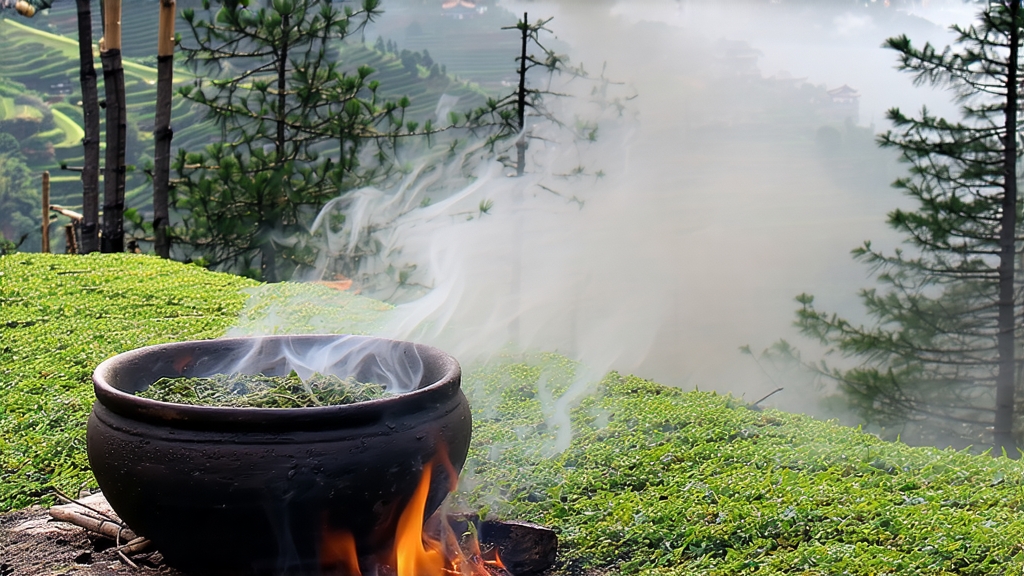
Ask most tea lovers to name a Chinese black tea and they will answer Keemun or Dian Hong; ask a historian which black tea came first and the reply is always Lapsang Souchong. Born in the cool, mineral-rich folds of the Wuyi range along the Fujian-Jiangxi border, this smoke-kissed leaf is the primogenitor of every red-black tea that followed. Its story begins in the late Ming dynasty, when passing armies forced village tea makers to speed-dry their harvest over available pine fires. The accidental alchemy of heat, resin and camellia sinensis created a liquor so fragrant that Dutch traders paid double for what they called “bohea,” a corruption of the local Wuyi Mountains. From Amsterdam the fashion spread to London coffeehouses, where Samuel Pepys first noted “a cup of China drink smoked” in 1667. In short, every sip of Assam, Ceylon or Earl Grey can trace its lineage back to that serendipitous moment when Wuyi farmers saved their crop from ruin.
Geography and cultivar matter. Authentic Lapsang Souchong is picked only between Qingming and Grain Rain from the small-leaf “cai cha” bushes that cling to rocky terraces at 600–1 200 m. The cool nights slow photosynthesis, concentrating sugars and amino acids; the granite soil imparts a flinty minerality that later balances the smoke. Two villages remain the spiritual heart: Tongmu Guan, where the original pine sheds still stand, and Xingcun, where subtler “unsmoked” versions are now crafted for the domestic market. Purists insist that only leaf processed inside the 60 km² core zone protected by China’s National Origin Product status can bear the name Zheng Shan Xiao Zhong—“Original Mountain Small Sort.”
Crafting Lapsang is a dialogue between wood, leaf and time. Picking follows the “two leaves and a bud” rule, but the leaves must be neither too tender nor too coarse; the goal is a cell wall sturdy enough to endure three separate firings. After a brief withering on bamboo screens in the upper rafters of the pine shed, the leaves are rolled by machine or, for the top grade, by hand until the edges bruise and oxidise to a coppery red. The crucial smoking stage follows: fresh pinus taiwanensis and massoniana logs are lit in a pit, then dampened so they smoulder rather than flame. The tea is placed on sieves 1.5 m above the smoke, absorbing phenols and sweet creosote for 6–8 hours. Masters repeat this cycle up to three times, resting the leaf overnight between smokings so the aroma migrates from surface to core. A final charcoal bake fixes the flavour, after which the leaf rests for at least a month to allow the smoke to mellow. The result is a glossy, midnight-black strip that smells of pine sap, longan fruit and dried lychee.
Yet not all Lapsang is a campfire in a cup. The modern market offers three stylistic branches. Traditional Smoke uses the full pine regimen and delivers a robust, tar-sweet liquor reminiscent of single-malt Islay whisky. Light Smoke shortens the exposure, yielding a cup in which cocoa and honey precede a whisper of ember. Unsmoked (often labelled “Wild/Old Bush”) omits the pine entirely, relying instead on long withering and low-temperature baking to coax natural notes of dried apricot, cinnamon and the Wuyi “yan yun” or rock rhyme. Each style has its disciples: European blenders crave the assertive smoke for Russian Caravan, while Beijing tea artists prize the unsmoked for its ability to age like a raw Pu-erh.
To brew Lapsang well, think of it as a whisky you can infuse. Start with mountain spring water brought to 95 °C; boiling water flattens the subtle sugars. Use 4 g of leaf for every 120 ml vessel—gaiwan, small Yixing teapot or even a tempered glass infuser. Rinse once to wake the leaf, discarding the amber wash after five seconds. The first proper infusion should last 8–10 seconds; subsequent steeps lengthen by 3–5 seconds. A seven-round gongfu sequence reveals an aromatic arc: campfire and pine resin in rounds one–two, dark chocolate and dried